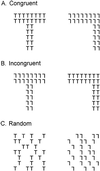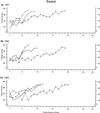Learning to see the trees before the forest: reversible deactivation of the superior colliculus during learning of local and global visual features
- PMID: 11891339
- PMCID: PMC122646
- DOI: 10.1073/pnas.062551899
Learning to see the trees before the forest: reversible deactivation of the superior colliculus during learning of local and global visual features
Abstract
Previous studies have established that deactivation of the superior colliculus severely retards the normally rapid learning of pattern discriminations in the mature cat. The purpose of this study was to test the hypothesis that the midbrain plays an important role in the learning of simple pattern discriminations and that the contribution of this pathway is to the perception of global, rather than local, features of a figure. To answer this question, pattern discrimination learning was studied in three intact cats and in three experimental cats during bilateral reversible deactivation of the superficial layers of the superior colliculus (SC). The animals concurrently learned to discriminate three pairs of compound visual patterns composed of small (local element) Ts or 7s. Congruent and incongruent stimulus pairs were large (global) Ts vs. 7s comprising the same or different local elements, respectively. The random stimulus pair consisted of randomly scattered local elements (Ts vs. 7s). The animals were trained to respond to the large Ts in the congruent and incongruent pairs and the small Ts in the random pair. In the normal cats, learning of the random pair was much slower than the learning of the congruent and incongruent pairs. This finding demonstrated the theory of global precedence, because the animals learned the global features of the congruent and incongruent pairs much more quickly than the local features of the random pair. In contrast, during bilateral deactivation of the superficial layers of the SC, the learning of the incongruent pair was significantly retarded and took longer to learn than the random pair. Congruent and random pair learning rates were unchanged. The specific deficit in learning the incongruent pair indicates that the learning of global, but not local, elements of the visual pattern is impaired during deactivation of the SC. The unimpaired use of local features permitted the animals to learn the congruent and random pairs at normal rates. Therefore, deactivation of the superficial layers of the SC during pattern discrimination learning reverses the precedence for global visual features that is typical of normal learning.
Figures





References
-
- Navon D. Cognit Psychol. 1977;9:153–183.
-
- Hughes H C, Layton W M, Baird J C, Lester L S. Percept Psychophys. 1984;35:361–371. - PubMed
-
- Kinchla R, Solis-Marcias V, Hoffman J. Percept Psychophys. 1983;33:1–10. - PubMed
-
- Horel J A. Behav Brain Res. 1994;65:157–164. - PubMed
-
- Schneider G E. Science. 1969;163:895–902. - PubMed
Publication types
MeSH terms
LinkOut - more resources
Full Text Sources
Miscellaneous

